Survival Guide in Cairo’s Souqs
Introduction
Shopping in Cairo could be an Olympic sport, from navigating whirling dervishes to reaching for a literal brass ring. Go prepared, and you’ll come home with everything from gold district bling to modern art from an ancient marketplace. It is also true that to experience Egypt fully, you must enter its markets – this is where you’ll see what has seduced countless invaders, explorers, and merchants for centuries. Souqs are the heart and soul of the country; prepare your five senses for a delightful onslaught. When shopping at street markets in Egypt, getting ready for a full-blown sensory overload is essential. You can be sure that each vendor will have its selling technique. Products might not be marked, and you can expect to ask for and negotiate selling prices. If you want the best price and quality, shopping around and checking the cost with a local you can trust is always a good idea. Also, the authenticity of locally made products must be ensured. If you’re not interested, answer the vendor with a kind but firm, “la, shukran” (‘no thank you’ in Arabic).
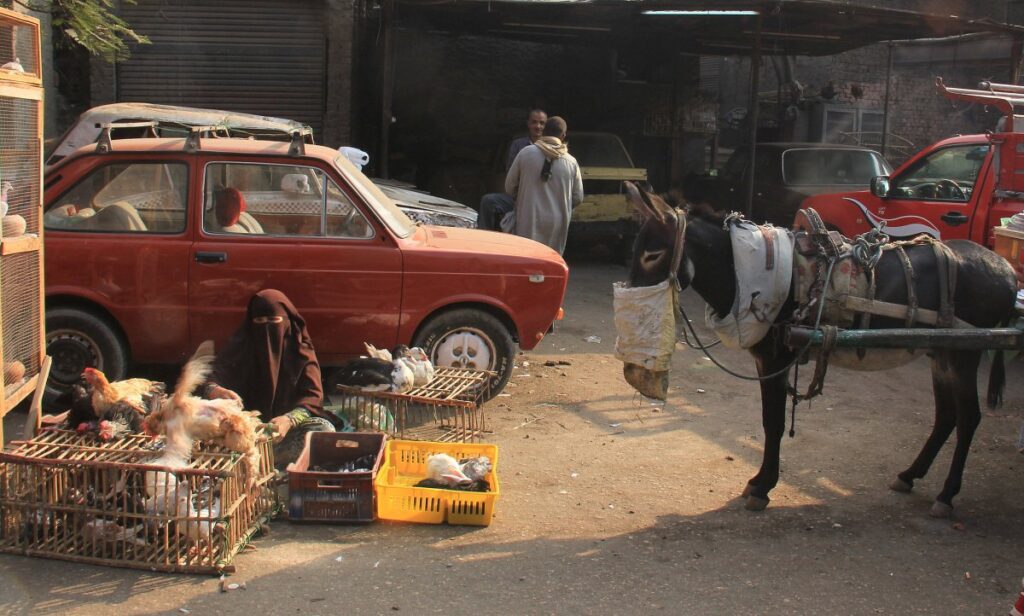
Expect vibrant colors to dazzle you at every turn, sparkly products thrust into your line of vision, and soft silks placed in your hand for you to admire. It’s common for sellers to try to get your attention with hisses and verbal patterns. Every few steps, you will hear ‘best spice here,’ ‘gift,’ ‘just one Egyptian pound,’ or questions about where you are from. Some aggressive touts may even grab your arm and steer you into their shop. Stay calm and be firm but polite when saying no. A simple ‘no shoqran’ should do the trick to end the sales pitch – at least until the next stall. Souqs tend to be divided by the products on sale, so you’ll find the spice stalls all in one area, fabrics in another, etc – all the easier for browsing and comparing prices.
What is a souq?
In Muslim countries, especially in North Africa and the Middle East, the word used to describe a marketplace is a souk or suq/souq (suːk ). In the sprawling capital of Egypt, Cairo, one can find an array of souks and bazaars. It’s here. Going from one stall to the next gives you a glimpse of life as it unfolds here daily. It’s all spice, adventure, and mystical allure. You will authentically encounter the locals and enjoy Cairo’s raw, unfiltered version!
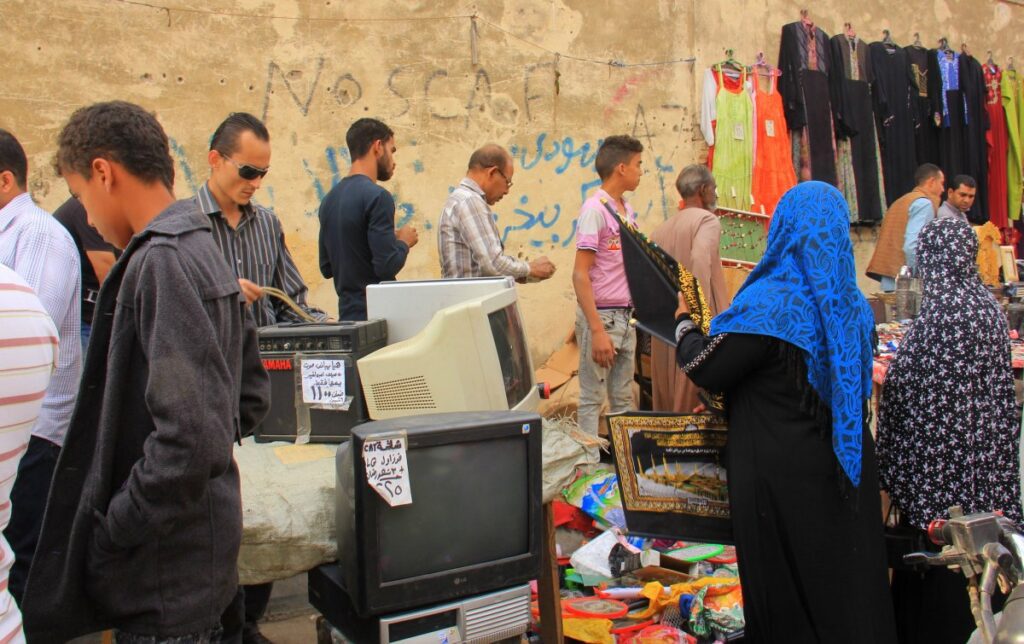
One of the oldest and most significant social, cultural, and economic traditions of the Middle East, souqs are where the Egyptians do their shopping and where you’ll also get a real glimpse of Egyptian daily life. An Egyptian souq is a place of frenetic activity, filled with noise, rich colors, and pungent smells. Goods will be transported by wheelbarrow, donkey, and on porters’ backs all around you, so watch your back and hold on tight to your money. Selling everything from aromatic spices to exotic vegetables and fruits, plus camels, gallabiyyas (traditional Egyptian floor-length ‘shirts’), and reams of cloth, the souqs are a great place to browse, particularly in the cool of the evening when people from all walks of life appear to be out exchanging news and gossip, running errands, transacting business and shopping for dinner.
How to haggle in Cairo’s Souqs
- Haggling is an integral part of the Egyptian shopping experience and should be considered a game rather than a battle. Here are a few tips:
- Ask the seller what the price is – never quote an offer first.
- Most dealers start their offers at an exorbitant price; suggest half of what the seller quotes you and go from there. The vendor will ridicule your quote amount, but keep smiling and firm.
- Don’t show too much interest in the item you want to buy.
- Only engage in the bargaining process if you are serious about buying, but be prepared to walk away empty-handed if the price is too high. You may be followed and offered a lower price once out in the street.
- Take a relaxed approach. Talk to the dealer at length, enjoy the tea you may be offered, and do not feel obligated to buy if you can’t get the right price.
- You can get an idea of prices by trying several shops and checking out the ‘fixed-price shops,’ where haggling is unnecessary.
- Don’t feel guilty about getting a low price; a vendor will not sell without making a profit.
Where to
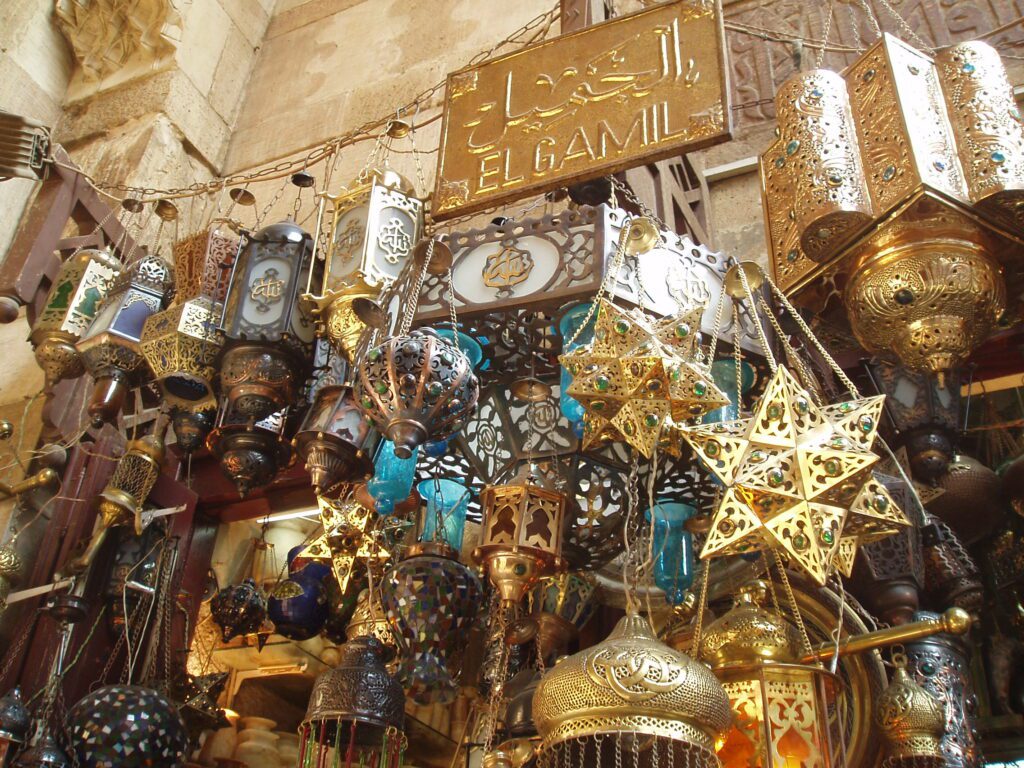
If you’re in the market for a shopping experience dating back to the 1300s, Khan Al-Khalili Bazaar (Map) is right up your alley. The medieval-era labyrinth of courtyards sells everything from glass pipes to brass lanterns, and scents of spices and perfumes fill the air. Merchants are legendary for their hard sell, so by all means, haggle. Once you’ve shopped till you drop, enjoy a refreshing cup of mint tea at the centuries-old El Fishawy Cafe (Map)(less crowded on weekdays) in the heart of the bazaar. Deep in the Khan Al-Khalili souk, you’ll find the Gold District — music to your ears if you’re in Cairo for precious metal. Craftspeople in the bazaar work their gold in ancient Egyptian tradition, and their jewelry is exquisite. Bring down the cost by buying bling in bulk when a particular booth strikes your fancy. Ask before photographing jewelry; most artisans don’t mind, but as with all art, some artisans like to keep their work private. Azza Fahmy, known as Egypt’s first lady of jewelry, apprenticed in the Gold District. Her international shops are famous for traditional filigree and calligraphy, and you can find a signature piece in her Zamalek District boutique.
On the Street of the Coppersmiths in the Gamaliyya District bazaar, navigate between donkey carts and street bustle for bargains like copper pots and trays. Haggle yourself into a matched set of one of the best cookware metals on earth. Once you’re set with pots and pans, visit the Souk al Attarin in Coptic Cairo for trays, bowls, and Egyptian herbs and spices. The Street of Bookbinders is behind Al-Azhar Mosque, so seek out a leather-bound notebook to make a note of your travels. And for more leather goods, hit the saddle-makers market for an array of hand-tooled items.
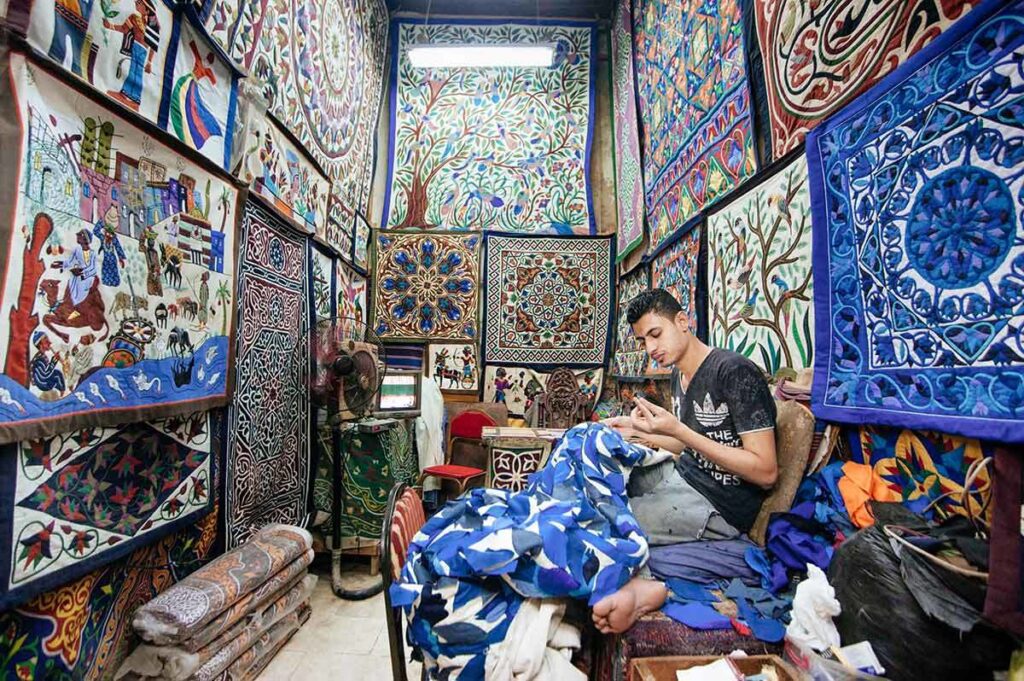
The Street of the Tentmakers is an exotic covered market dating back to the 1600s. Visit the medieval site just south of the Bab Zuweila gates in Old Cairo to watch craftspeople ply their trade, dating back to when caravans would come through town for a tent upgrade. Pickup colorful tapestries and quilts are made with traditional Khayamiya-style applique. if you’re not tent shopping
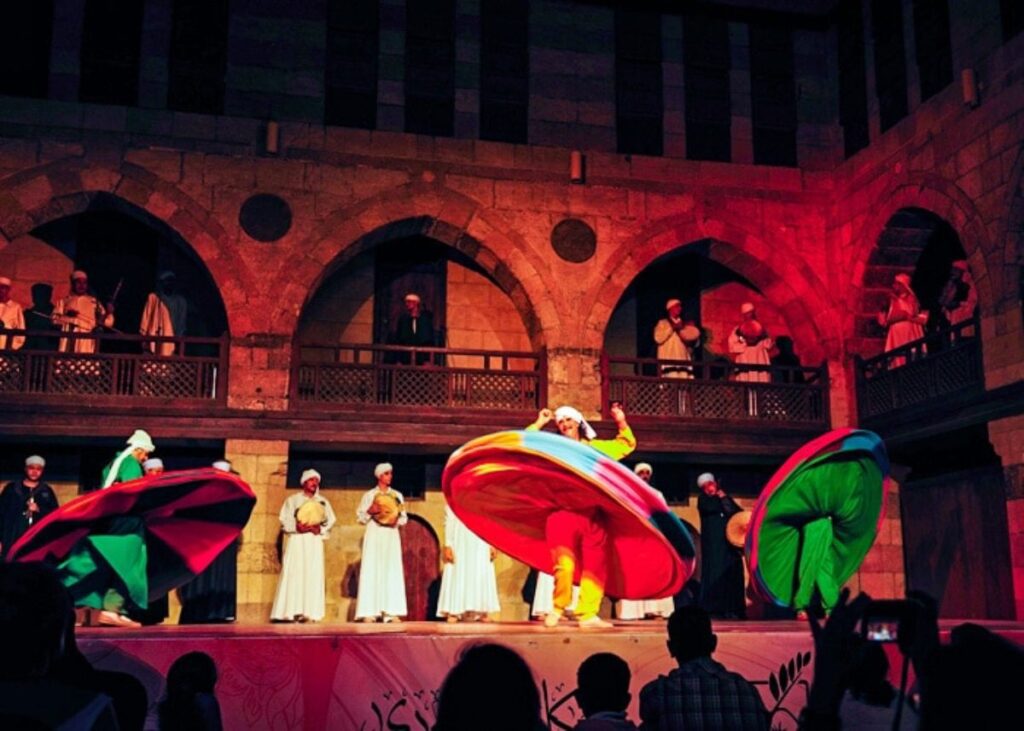
Wekalet El Ghouri Arts Center is housed in another former caravan marketplace where medieval traders would stop, and it’s now home to a Sufi dance troupe at 3 Mohamed Abdo Street. Shop for textiles and artwork in the arts center by day, and on Wednesday and Saturday nights, the 14th-century market’s courtyard hosts whirling dervish performances that will leave you both dizzy and dazzled. The 7:30 p.m. show is popular, so arrive early and be ready for a rush at the gate.
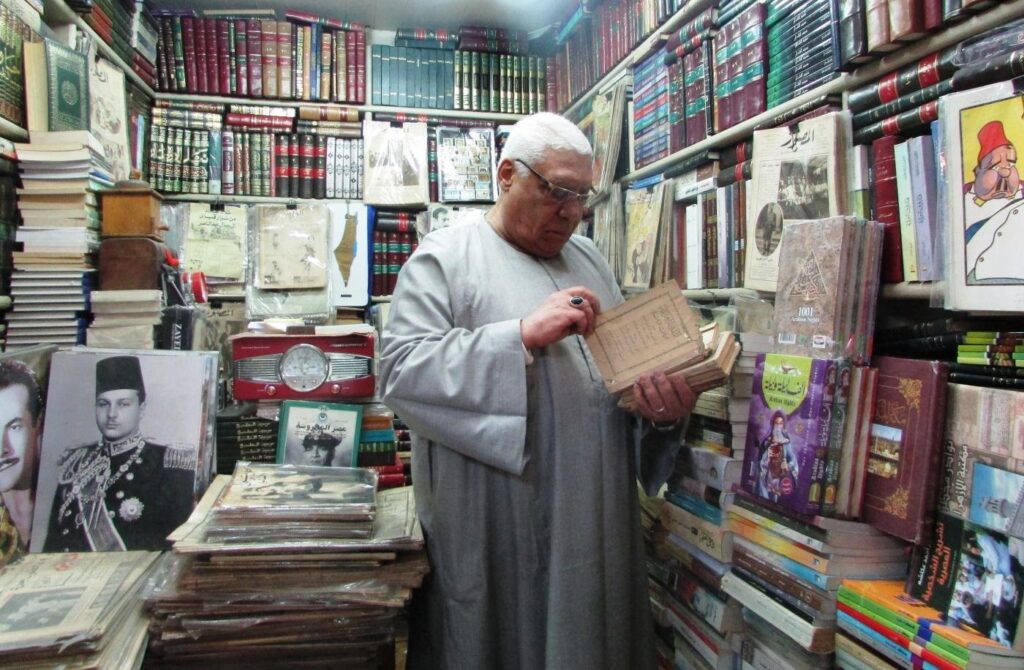
Go to El Azbakeya Wall to buy old, rare, and used books dating back to the 1800s at 130+ stalls. The market area is close to the Azbakeya Gardens. You might find exciting gems like Arabic alphabet posters among the stacks of travel guides, history books, and literary masterpieces (on any imaginable subject). Truly a haven for book lovers!
Souq El Gom’aa is a famous, non-tourist market where you can find almost anything and everything, or as Egyptians say, “from needle to rock.” It’s perfect if you’re not sure what you’re shopping for, and the prices are affordable. Take care of your pockets, purses, and wallets – this market is renowned for being super busy, and pickpockets might be roaming around.
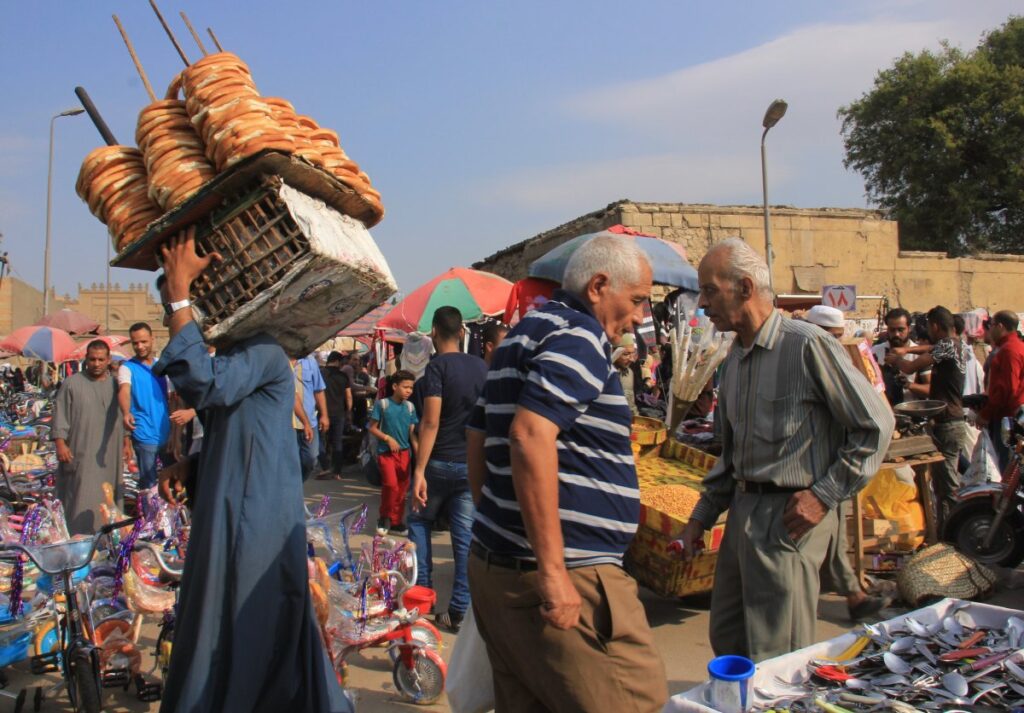
Established in the 19th century, Wekalet El Balah is one of the most famous markets that sells medium-quality and second-hand imported clothes. Shoppers can also find affordable fabrics, shoes, bags and furniture. Merchandise can be local or imported from countries like China and Turkey. The market dates back to when traders from Upper Egypt (Aswan) came to Cairo carrying supplies. El-Wekala, as the locals know it, is known to be an adventurous shopping experience because of the chaos, haggling, and abundance of stalls










